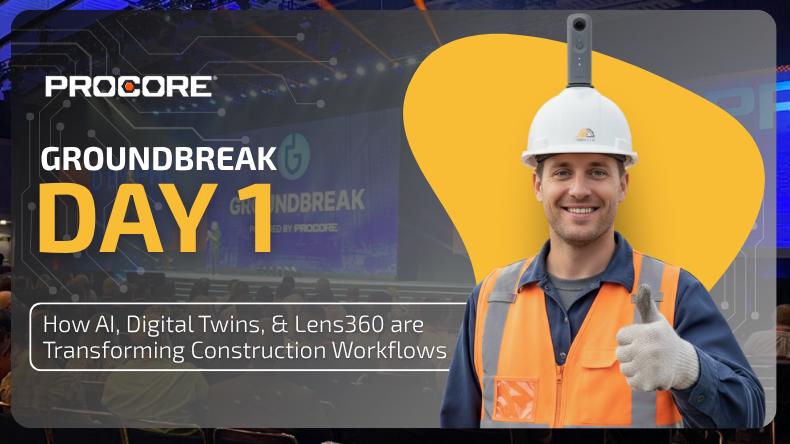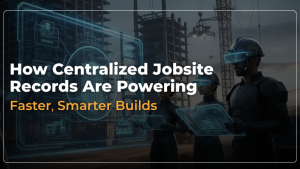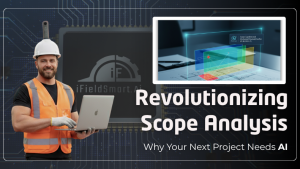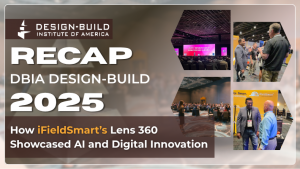Reading Time: 7 minutes
Day one at Procore Groundbreak 2025 hit different this year. Walking into the conference, you could feel it. The energy wasn’t just about software updates or platform features anymore. Every conversation, every keynote, every demo on the floor kept circling back to one thing: AI actually working on job sites.
We’re here at Booth #1210 with Lens360 by iFieldSmart.ai as exhibitors, and honestly, we came to learn just as much as we came to share. What we’re seeing from project teams, GCs, trade contractors, and owners is a shift. People are no longer asking if they should adopt digital tools. They’re asking how to make them stick.
Here’s what stood out from Day 1, and where things are heading.
Work Smarter, Not Harder
iFieldSmart empowers your team with AI-driven efficiency to simplify scheduling, boost collaboration, and keep projects on track.
Schedule a MeetingAI Is Driving the Next Evolution in Construction
The future of construction isn’t about replacing people with machines. It’s about giving field teams better information, faster.
Here’s the thing: AI only works if someone feeds it real data. Not guesses. Not outdated drawings. Actual conditions from the site, captured consistently and connected to the tools your team already uses.
That is where digital twin technology enters the picture. It acts as a living model of your project, updating in real time as work moves forward. Teams capture 360° photos to detect clashes, track progress without visiting the jobsite, and make decisions based on what’s actually built, not outdated plans from six months ago.
What this really means is fewer surprises, fewer RFIs that sit unanswered, and fewer arguments about what was supposed to happen versus what did.
Why Connected Workflows Matter
Before the main sessions began, we attended several workshops. While product training may seem routine, it’s where the true challenges teams face come into focus.
The biggest pain point? Data integration.
Everyone’s using five different tools. The estimating team has its software. VDC is on another platform. Field teams are still taking photos on their phones and uploading them manually. By the time information reaches the office, decisions are already late.
One workshop walked through how Autodesk Construction Cloud connects with Procore workflows. It shows RFI responses linked directly to 360-degree site captures, so when someone asks, “What does it look like right now?” you’re not digging through folders or waiting for the super to send a photo.
We’ve seen this play out with our own users. Lens360 integrates directly with Procore, pulling in site documentation, progress photos, and constructibility reviews without adding another login or another step. It’s not about having more tools. It’s about making the ones you talk to each other.
AI in Design and Productivity
One of the breakout discussions focused on the real-world applications of AI in construction. The sessions promised theoretical discussion but delivered refreshingly practical insights. They explained how people are applying AI:
- Clash detection that actually works (not just flagging every pipe that gets close to a beam)
- Progress tracking that doesn’t require a site walk every time
- Productivity analysis that tells you where crews are moving fast and where they’re stuck
- AI assistants offering instant project insights through an AI chatbot, providing quick answers and helping teams make smarter decisions
- VR and AR walkthroughs that allow teams to experience the project before it’s built, enabling better design validation, pre-install coordination, and stakeholder alignment
But here’s the catch: AI needs clean inputs. If your field data is inconsistent, incomplete, or buried in someone’s camera roll, the AI can’t help you.
The teams seeing results are the ones capturing site conditions regularly and feeding that into their VDC solutions. They are taking advantage of 360° capture, progress tracking tools, and structured observation reports, all directly connected to real-time coordination schedules and budgets.
When the digital twin reflects the real conditions of the site, you can identify problems before they cost you time or money. You can see if that MEP rough-in actually happened on schedule. You can verify the submittals against the installations.
Data-Driven Jobsite Safety
Most teams are still doing safety walks with clipboards. By the time that report gets typed up and sent around, the hazard might already be fixed.
What if your safety observations were captured in real time, geotagged to the exact location, and pushed to the right people instantly?
That’s not a “nice to have” anymore. With Lens360’s AI-powered reporting, you can track patterns. You can see which trades are having repeat issues. You can prove compliance without drowning in paperwork.
We’ve talked to project managers who’ve cut their observation report time in half by using linked visuals and automated workflows. Instead of describing where the problem is, you drop a pin on the digital twin. Instead of typing paragraphs, you snap a photo, and the system auto-generates the report format.
Inspections get faster. Accountability gets clearer. And everyone goes home safe.
Analytics and Predictive Insights
What this really means is: Teams don’t want just tracking where they are today. They want forecasting where they’ll be in three months based on current productivity rates, material delivery schedules, and actual site conditions.
You can’t forecast accurately if your data is two weeks old. You want information from the field in real time, and you want it connected to your schedule, your budget, and your risk register.
For teams managing large, complex builds, this level of connected visibility isn’t just valuable, it’s transformative. You can catch budget overruns before they spiral. You can see when a critical path activity is falling behind while there’s still time to adjust.
AI Agents and Workflow Automation
- Flag incomplete submittals
- Route approvals based on project rules
- Generate reports from field data
- Track punch list items and send reminders
But they need structured data to work with. If your field documentation is inconsistent, the AI can’t automate anything.
This is where tools like Lens360 fit in. By capturing 360-degree site conditions consistently, you create a data stream that AI can actually use. The agent knows what to look for, where to look, and who to notify when something’s off.
The result? Less manual effort. Faster turnaround on approvals. Fewer things falling through the cracks.
What We’re Hearing at Booth 1210
We’ve had dozens of conversations today. Project managers, supers, VDC coordinators, and owners. And a few themes keep coming up:
- People want tools that actually save time. Not tools that add steps. Not platforms that require three hours of training. They want something that makes their job easier on Day 1.
- Integration is everything. If it doesn’t connect to Procore, Autodesk, or other systems they are already using, it’s a non-starter.
- Proof matters. Teams want to see it working on a project like theirs. They want to talk to someone who’s already using it and can vouch for the results.
We’ve been showing live demos of our 360-degree captures and AR/VR walkthroughs. The reactions have been great. And the best part has been hearing what people are struggling with and how we can help solve it.
Key Takeaways from Day 1
- AI is only as good as your data. You can’t automate bad inputs. You need consistent, accurate field documentation.
- Digital twins are becoming standard. Not just for VDC teams. For everyone. Field crews, subs, owners. Everyone benefits from having a single source of truth.
- Real-time beats reactive. Waiting for the next meeting to address problems costs you time and money. Real-time data lets you fix things before they lead to a larger risk.
- Integration wins. The teams seeing the biggest gains aren’t using the fanciest tools. They’re using tools that connect and eliminate double entry.
- Safety and quality are measurable. With the right systems, you can track compliance, catch patterns, and improve outcomes without adding admin work.
Looking Forward to Day 2
We are looking forward to what happens tomorrow. When we return to Booth 1210, we will again be up for more demos and conversations.
If you are in Groundbreak, stop at booth #1210. We will share how Lens360 contributes to your workflow and learn what challenges you’re facing.
The future of construction is not about acquiring the largest number of tools. It’s about having the right ones, working together, giving your team the information they need to make better decisions faster.
That’s what Day 1 taught us. And that’s what we’re building toward.
Visit it at booth #1210 to explore the Lens360 by iFieldSmart.ai, which leverages AI, digital twins, and connected workflows to drive smarter, faster, and more efficient project delivery.








